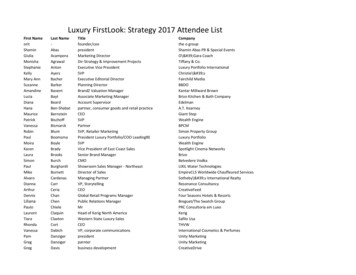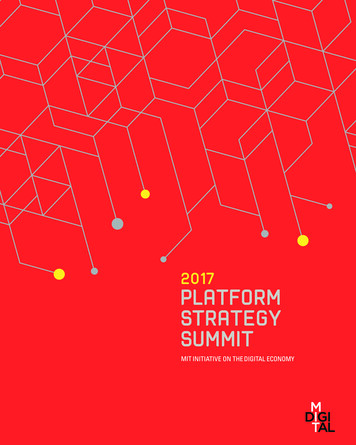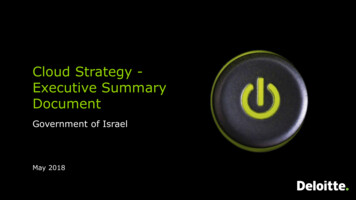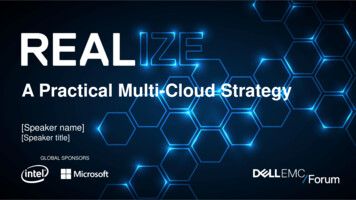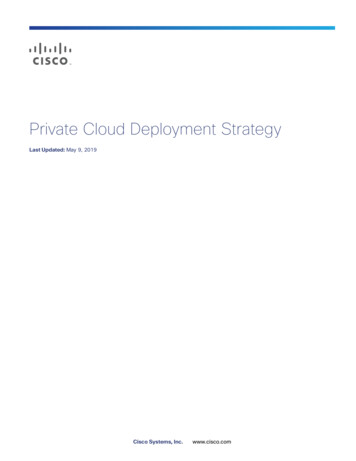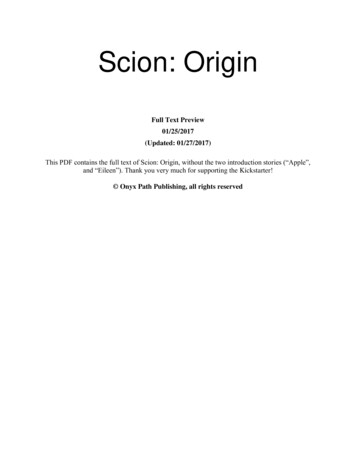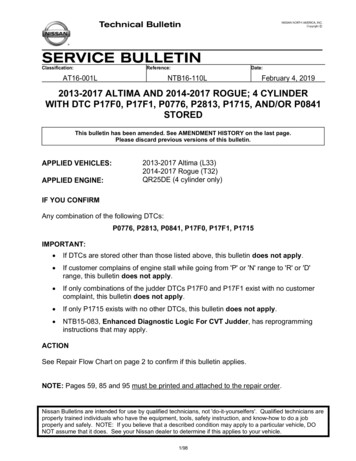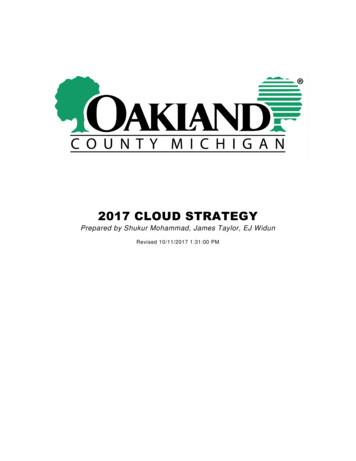
Transcription
2017 CLOUD STRATEGYPrepared by Shukur Mohammad, James Taylor, EJ WidunRevised 10/11/2017 1:31:00 PM
Prepared by Shukur Mohammad, James Taylor, EJ WidunExecutive Summary . 3Definitions, Attributes & Taxanomy . 4What is Cloud Computing? . 4Attributes of Cloud Computing . 4Cloud Deployment Models . 4Cloud Computing Service Models . 5Software as a Service (SaaS) . 5Platform as a Service (PaaS) . 6Infrastructure as a Service (IaaS) . 6Why Cloud? . 7Cloud is a Fundamental Shift in IT . 7Efficiency Improvements will Shift Resources Towards Higher-Value Activities . 7Services will be more Scalable . 7Agility Improvements will make Services more Responsive . 7Innovation Improvements will Rapidly Enhance Service E ffectiveness . 7Assets will be Better Utilized . 8Portability and Flexibility . 8Creating the Cloud Culture . 9Roadmap for Cloud Migration . 101.2.3.4.5.6.7.8.9.10.11.Create a Cloud Strategy .Establish a Cloud Program .Cloud Discovery .Define Governance Structure .Implement Core Technologies .Assess and Plan .Build and Pilot .Application Migrations .Operational Integration and Environment Optimization .Define EA Policies .Cost/Billing Analysis & Management .1111111111121516161616Appendices . 17Appendix A - Abbreviations and Acronyms . 17Appendix B - Systems/Applications Migrations and Considerations . 18References . 19Links . 19Revised 10/11/2017 1:31:00 PMPage 2 of 19
Prepared by Shukur Mohammad, James Taylor, EJ WidunEXECUTIVE SUMMARYAs technology continues to evolve so does Oakland County Information Technology’s (OCIT) infrastructureenvironment and development model. The overarching goal of OCIT ‘s Cloud Strategy is the ability to run any timeand run any where. This means that OCIT needs to have the ability to support cloud and on -premise solutions;where the optimal configuration for performance , reliability and cost can be selected.For the purposes of streamlining the run any time and run any where strategy, we will determine on a case by casebasis where a workload should reside, and will construct environments where the solutions are either all in the cloudor on-premises. Splitting workloads between the cloud and on-premises reduces the effectiveness and efficiency ofboth technology platforms.As we look toward our future, Oakland County (OC) is looking to establish a Cloud First approach to applicationinfrastructures. The Cloud will provide Oakland County with several benefits including econ omies of scale, removal ofnon-value added tasks from daily workloads, increased innovation and improved collaboration across IT. We willestablish the standards that govern our cl oud environments and enable the Cloud First mindset through our TechnicalDesign Review process.Oakland County has been leveraging cloud computing technologies for some time. We have many successfulSoftware as a Service (SaaS) implementations and some Infrastructure as a Service implementations. O urpreliminary experiences with Infrastructure as a Service (IaaS) and Platform as a Service (PaaS) suggest that theyare suitable for agile, rapid development and deployments.With the convergence of market trends, successful cloud deployments and upcoming technology projects, now is thetime for Oakland County to transform the way we do business. We cannot take our current processes and adaptthem to the cloud. We need to create a new way of doing bu siness that leverages all of the value propositionsof cloud. These new and improved processes may be applied to our on-premises infrastructure to take advantagesof the lessons learnt in the cloud as a part of our Outside-In approach.A true cloud strategy includes a holistic view of IT that require s partnership, collaboration and the support ofleadership to remove the barriers to the cultural chage.This Cloud Strategy will:1.2.3.4.5.6.7.8.Define the cloud and its components creating a common and shared lexicon for OC.Articulate the benefits, considerations, and trade -offs of cloud computing.Identify the program, activities, roles and responsibilities for our transformation to Cloud First computing.Provide a high-level roadmap for cloud migrations.Provide a deicison framework for solutions to migrate to the cloud.Define the Cloud connection methodologies.Ensure the security requirements are included and met.Establish the governance policies of the cloud.Revised 10/11/2017 1:31:00 PMPage 3 of 19
Prepared by Shukur Mohammad, James Taylor, EJ WidunDEFINITIONS, ATTRIBUTES & TAXANOMYWhat is Cloud Computing?“Cloud Computing is a style of computing where elastically scalable technical capabilities are delivered as a serviceusing Internet technologies.” – GartnerAttributes of Cloud Computing Abstraction – infrastructure abstracted from the customer and delivered as a service.Agility – ability to provision and re-provision infrastructure resources since it is delivered as a service.Reliability – improved availability with multiple redundant sites.Scalability – ability to accommodate varying loads (scale-up, down or scale-out).Elasticity – ability to cope with loads dynamically.Security – provides a secure infrastructure.Performance – is reliable and can be monitored.Maintenance – is easier to maintain with self-service for all configurations.Multi-tenancy – ability to host multiple tenants.Metered usage – ability to monitor and control usage. Pay as you go model to reduce capital expenditures.Cloud Computing can deliver System Infrastructure components (Network, Storage, Servers, Load Balance rs etc.),Application Infrastructure components (Services, Platforms, Applications, etc.) and provide s licensing flexibility (Bringyour own License or purchase from the service provider).Cloud Deployment ModelsDeploymentModelDefinitionExamplesPrivate CloudCloud Infrastructure operated solely for asingle organization, whether managedinternally or by a third-party, and may behosted either on-premise or off-premise.OpenStack, VMWare Private Cloud,IBM SoftLayer, etc.Public CloudCloud Infrastructure made available to thegeneral public or a large industry group andis owned by an organization providingcloud services.AWS, Azure, Rackspace, etc.Hybrid CloudCloud Infrastructure delivered by somecombination of private and public servi ces,from different service providers.Cloud bursting for load-balancingbetween clouds.The cloud infrastructure is a composition oftwo or more clouds (private, community, orpublic) that remain unique entities but arebound together by standardized orproprietary technology that enables dataand application portability.CommunityCloudCloud Infrastructure shared by severalorganzations and supports a specificcommunity that has shared concerns (e.g.,security requirements, policies andcompliance considerations, industryRevised 10/11/2017 1:31:00 PMApplication deployed to the cloudinfrastructure and data is on-premises.AWS GovCloud, Azure GovernmentCommunity Cloud.AWS and Azure Government cloudshost environments for several federal,Page 4 of 19
Prepared by Shukur Mohammad, James Taylor, EJ Widunrequirements).state and local government entities.It may be managed by the organizationsthemselves or a third party, and may existon-premise or off-premise.Cloud Computing Service ModelsFigure 1 shows the comparison options of the different cloud computing service models. A typical de ployment in thecloud environment for an OC application could include components in each of the three cloud service models.Figure 1: Comparing Cloud Computing service modelsSoftware as a Service (SaaS)The capability provided to the customer is to use the provider’s applications running on a cloud infrastructure.Theapplications are accessible from various client devices through a thin client interface such as a web browser (e.g.,web-based email).The customer does not manage or control the u nderlying cloud infrastructure including network,servers, operating systems, storage, or even individual application capabilities, with the possible exception of limiteduser-specific application configuration settings. Applications are typically upgraded and maintained by the SaaSprovider.Some examples include: SalesForce, Kronos, ArcGIS Online, Office 365, etc.Pros: Quick implementation – since there is no hardware or software to setup and configure, the implementationtimes are greatly reduced.Zero planned upgrades – the service provider is responsible for all planned upgrades. OC may need to testthe changes for some planned upgrades with the vendor.Revised 10/11/2017 1:31:00 PMPage 5 of 19
Prepared by Shukur Mohammad, James Taylor, EJ Widun Patches and Upgrades – are automatically applied (more often on a scheduled timeframe). This ensures thecustomer always uses the most current version of the softwareand also includes the latest security patches.Availability and Redundancy – is the responsibility of the service provider.Backup and Retention – is the responsibility of the service provid er.Security – is the reponsibility of the service provider. This includes security compliance testing, scans,certificates, etc.Cons: Control – the customer has little control over the application other than who has access. The customer canalter configurations, but not to customize the core functionality. Vendor lock-in – switching to a new vendor may become difficult, especially with customizations. Patches/Upgrades – Patches and upgrades to the software are automatically applied (more often on ascheduled timeframe). There will not be an option to back out of certain patches or upgrades as the customerhas may not have a say in the pre-established SLAs, maintenance windows, etc. Integration – integrating with on-premises data and applications may require additional effort, since the datais hosted by the service provider.Platform as a Service (PaaS)The customer is provided the ability to deploy onto the cloud infrastructure customer-created or acquired applicationscreated using programming languages and tools supported by the provider. The customer does not manage or controlthe underlying cloud infrastructure including network, servers, operating systems, or storage, but has control over thedeployed applications and possibly applica tion hosting environment configurations.Some examples include: AWS RDS, Azure App Service, etc.Pros: Server-less Architecture – the customer does not have to manage hardware, operating systems, databasesystems, and programming stack servers are not required to stand -up the components of the solution. Thisleads to faster implementation of the solution as there is no installation of the platform required.Allocated Resources – is configurable and can be scheduled and scaled in most cases, if required.Features – more features are readily available, which would otherwise require installation and configurationof additional components.Backups – are easily handled with standard and established procedures.High-Availability and Redundancy – can be configured.Security – is implemented with industry best practices for the platform.Cons: Vendor lock-in – switching to a new vendor may require coding changes, and re-architecting, which can betime consuming, based on the complexity the solution. Patches/Upgrades – Patches and upgrades to the platform are automatically applied (more often on ascheduled timeframe). There will not be an option to back out of certain patches or upgrades.Infrastructure as a Service (IaaS)The customer is provided the ability to provision processing, storage, networks and other fundamental computingresources where the customer is able to deploy and run arbitrary software, which can include operating systems andapplications. The customer does not manage or control the underlying cloud infrastructure but has control overoperating systems, storage, deployed applications and possibly limited control of select networking components.Some examples include: AWS, Azure, Rackspace, IBM SoftLayer, etc.Pros: Custom Architecture – the customer has complete freedom in designing the architecture as required by theapplications. This means that the customer must manage operating systems, database systems andRevised 10/11/2017 1:31:00 PMPage 6 of 19
Prepared by Shukur Mohammad, James Taylor, EJ Widun programming stack servers. This provides complete control to building a custom architecture and implementcustom components.Allocated Resources – is configurable and can be scheduled and scaled, if required.Backups – are handled with customer standards and established procedures.High-Availability and Redundancy – can be configured using customer solutions.Security – is implemented with industry best practices by the customer.Vendor lock-in – switching to a new service provider most likely will not require rearchitecting the solutionand coding changes.Cons: Maintenance – Since the architecture is designed by the customer, the customer holds the responsibilitues ofadministering and maintaining the entire architecture, which could include security, firewalls, monitoring,alerting, etc. Patches/Upgrades – Patches and upgrades to the to the infrastructure have to be managed by the customer.WHY CLOUD?Cloud is a Fundamental Shift in ITCloud computing enables IT systems to be scalable and elastic. We as OCIT, do not need to determine their exactcomputing resource requirements upfront. Instead, we provision computing resources as required, on -demand. Usingcloud computing services, OCIT does not need to own data center infrastructure to launch a capabi lity that reliablyserves thousands of concurrent users , but instead can leverage the pay-as-you-go model for provisioning newinfrastructure.Using a public or community cloud like AWS or Azure would give OCIT access to infrastructure and servicesrelatively inexpensively, in minutes. In our current environment, it would take months to procure and configurecomparable resources and significant management oversight to monitor , maintain and upgrade systems. Applyingcloud technologies across OC can yield tre mendous benefits in efficiency, agility, and innovation.Efficiency Improvements will Shift Resources Towards Higher-Value ActivitiesImprovements in efficiency will be seen in software applications and end -user support. These savings can be used toincrease capacity or be reinvested in other alternatives, including citizen-facing services and inventing and deployingnew innovations.Services will be more ScalableWith a larger pool of resources to draw from, individual cloud services are unlikely to encou nter capacity constraints.As a result, services hosted in the cloud would be able to more rapidly increase capacity and avoid service outages.Given appropriate service level agreements and governance to ensure overall capacity is met, cloud computing wil lmake the OCIT’s investments less sensitive to the uncertainty in demand forecasts.Agility Improvements will make Services more ResponsiveCloud computing will also allow OCIT to improve services and respond to changing needs and regulations much morequickly. With traditional infrastructure, OCIT’s service reliability is strongly dependent upon the ability to predictservice demand, which is not always possible Cloud computing will allow OCIT to rapidly scale up to meetunpredictable demand thus minimizing similar disruptions. Notably, cloud computing also provides an importantoption in meeting short-term computing needs; applications need not invest in infrastructure in cases where service isneeded for a limited period of time.Innovation Improvements will Rapidly Enhance Service EffectivenessCloud computing will not only make our IT services more efficient and agile, it will also serve as an enabler forinnovation. Cloud computing allows the OCIT to use its investments in a more innovative way and wi ll help OCIT takeadvantage of leading-edge technologies.Revised 10/11/2017 1:31:00 PMPage 7 of 19
Prepared by Shukur Mohammad, James Taylor, EJ WidunAssets will be better UtilizedLow utilization is not necessarily a consequence of poor management, but instead, a result of the need to ensure thatthere is reserve capacity to meet periodic or unexpected demand for key functions.With cloud computing, total infrastructure resources are pooled and shared acro
Cloud bursting for load-balancing between clouds. Application deployed to the cloud infrastructure and data is on-premises. Community Cloud Cloud Infrastructure shared by several organzations and supports a specific community that has shared concerns (e.g., security requi

